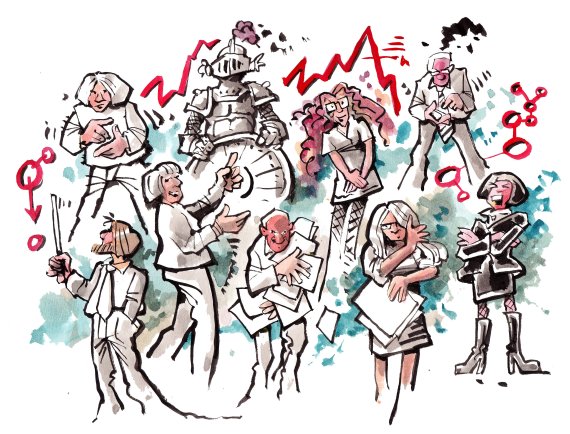© Henk van Ruitenbeek
The trips are often amazing. Some exotic location abroad, complete with hotel and gala dinner. Yet many young researchers and students dread scientific conferences. That is because they are usually expected to present their own research. Often according to a strict timetable with 15 to 20 allotted minutes, which hardly helps their nerves. Listening critically to their talk is a group of fellow scientists who might come from anywhere and might ask all kinds of questions.
Huge pressure
A snazzy presentation is often also a crucial element in securing research funding. A lot depends on such presentations. For young researchers who want to continue after their PhD, the amount at stake can easily be a couple of hundred thousand euros — including their own salary. No grant often means no job. For researchers further on in their career, the amount can even reach several million.
But winning a grant is not easy. For example, under 14 percent of the applicants for a Veni grant had their application honoured. That puts huge pressure on young researchers.
Just a few slides
PhD students and other researchers who feel unable to cope with the pressure, or who simply want to be well prepared, can turn to Wageningen in’to Languages. WUR’s language centre, which collaborates closely with Radboud University’s language centre in Nijmegen, gives a number of different courses in presentation skills, as well as customized advice where necessary.
‘We regularly see people who are about to give an important presentation and are not very well prepared at all,’ says trainer Janou Hemsing. ‘We try to help them create a good presentation step by step. And that works.’ Together with her colleague Inez Zondag, she came up with the following five tips.
1. Be your own best friend
‘Being nervous is fine — I’ve yet to meet someone who wasn’t,’ says Hemsing. ‘There’s often a lot at stake and you don’t need to pretend otherwise. Make sure you have a way of releasing the tension. Above all, don’t talk yourself into a hole, which is what often happens. People picture all the things that could go wrong in a presentation. Or they tell themselves how bad their own research is. That kind of thinking doesn’t help you give a better talk, of course. Imagine yourself as your own best friend and say to yourself what they would say. That helps you approach the presentation more positively.’
2. Include pauses
‘It’s important to pause now and then. That makes the words come across much better,’ explains Zondag. ‘You have to develop a tolerance for such moments of silence, but just try it. Pause after you’ve said something important.’ Another useful tip: start your presentation with three seconds of silence. Zondag: ‘Those are the best presentations. Just walk up to the front and say nothing. That gets people’s attention from the start.’
3. Don’t start with an old PowerPoint file
‘People often start off by creating their slides. Or even worse, by opening an old presentation,’ says Hemsing. ‘Then they say: “I’ve got all the slides I need for the Veni grant presentation. I just have to put them in the right order.” That’s when it goes wrong.’ If you do this, the slides determine the story, which is not the intention. Hemsing: ‘Start with the story you want to tell. What’s your main message? What do you want the audience to come away with? Only once you’ve got that straight should you start thinking about your slides. Start preferably with a concise key message, then add supporting evidence. Perhaps you have already produced your slides and don’t have enough time to start all over again. Then it often helps to place the last slide first, because that slide frequently has the key message hidden in it.’
4. Stand to the left of your slides
A minor but effective tip from Zondag: ‘Position yourself on the left of your slides. People automatically read from left to right. If you are on the left, they will see you first. Though I don’t know whether this also applies to the Japanese, who read from right to left. Incidentally, you should put as little text as possible in your slides. Everyone knows this but a lot of people still break this rule without realizing.’
5. Stop giving a presentation
‘The most important tip is actually to stop giving a presentation,’ says Zondag. As soon as people start ‘presenting’ their work, they lose all contact with the audience and focus too much on the content. That often comes across as rather constrained and pre-programmed. ‘A conversational mode works much better and the tone is pleasanter too. So try to approach it as if you’re having a conversation with your audience rather than giving a presentation.’ That’s how all the training courses start at Wageningen in’to Languages, says Zondag. ‘We ask someone to tell us about their research. Then we keep taking a step backwards until we have created a presentation setting. That often works. People talk about their research in a more natural way, which is basically what you want to achieve in an actual presentation.’
Go to wur.eu/into to see the range of courses offered by Wageningen in’to Languages.

